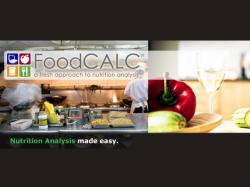Wood County, WI Teams With FoodCALC To Implement Smart Meal Program
June 2, 2011 | 3 min to read

San Francisco, CA – Restaurant owners in Wood County, Wisconsin, now have the opportunity to improve access to healthy food and promote a healthier lifestyle in their community by using FoodCALC’s nutrition analysis program to become a Smart Meal restaurant.
Wood County has partnered with National Restaurant Association endorsed provider FoodCALC to assist restaurant operators in analyzing the nutritional content of their menu items for participation in the Smart Meal program. The program, which labels lower calorie, nutrition meals in participating restaurants, uses FoodCALC’s nationally recognized web-based online tool to calculate nutrition results for restaurant menu items. Menu analysis results are user-friendly and easy to compare with Smart Meal guidelines to ensure a restaurant’s compliance with the program.
FoodCALC was chosen as the program’s analysis provider based on its easy-to-use online interface and credibility within the restaurant and foodservice industry. Based in San Francisco, California, the company also has previous experience working at the county level on health initiatives, including Erie County, New York.
“FoodCALC is honored to supply nutrition information for such a wonderful community initiative to promote healthier living,” said the company’s CEO and Founder, Lucy Logan. “The Smart Meal program is a leading example of how restaurants and nutrition can co-exist and collaborate in a meaningful way.”
For adult meals to qualify for the Smart Meal program, they must contain two or more servings of beans, whole grains, fruits, or vegetables. Other requirements include: 700 calories or fewer; 30 percent or less of total calories from fat or 23 grams or fewer of total fat; 10 percent or less of calories from saturated fat or 8 grams or fewer of saturated fat; 0.5 grams or fewer of trans fat; and 1,500 mg or fewer of sodium.
Smart Meal also has similar requirements for qualifying adult side dishes and kids’ meals.
Compliance can be assured through using MenuCalc, FoodCALC’s online nutritional calculator, to compare a restaurant’s recipes with the Smart Meal guidelines. "It's really easy to use, very informative and a great tool to use to help create healthy recipes,” said Jeff Hammerstad, Kitchen Manager of the Occupational Development Center in Wisconsin Rapids.
In addition to the efforts to curb obesity and chronic disease, the Smart Meal program was developed to help restaurateurs meet the growing consumer demand for healthier options when dining out, and make it easier for restaurant patrons to identify healthier choices. Benefits of joining the program go further than community wellness; building customer loyalty among healthy-minded diners is an added advantage. "It's a great way to show customers you care about them and their health," said Don Thompson, owner of Red Mill Supper Club and president of the Wisconsin River Valley Chapter of the Wisconsin Restaurant Association. "Not only does menu labeling equip customers to make healthier selections, I think it will also help restaurants increase business and attract new customers."
Research shows that U.S. adults spend half of their food dollars on means and snacks away from home. With the popularity of dining out, restaurant owners and chefs have the opportunity to promote healthy selections for their customers through this program, which aims to assist patrons to make informed decisions when they are placing an order.
As part of the program, participating restaurants receive free menu analysis for four meals, training, support, and promotional items, including window decals and panel cards. A discounted rate has been arranged for restaurants wanting to do nutrient analysis for additional menu items.
The Smart Meal program is part of the Get Active – Cause. Community. Change. Initiative and is endorsed by the Healthy People Wood County Obesity Prevention Team. The U.S. Department of Health and Human Services, the Wisconsin Department of Health Services, and the Wood County Health Department have sponsored the program.
Source: FoodCALC
